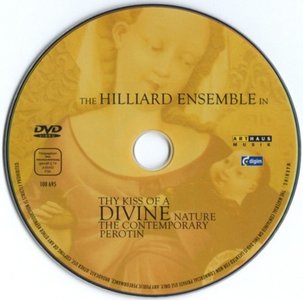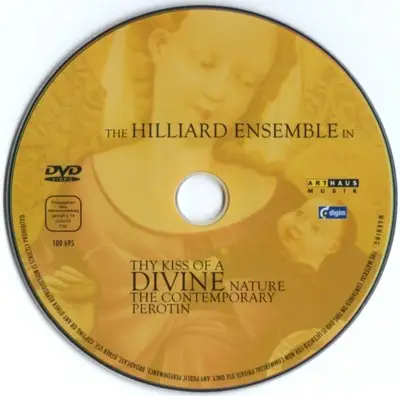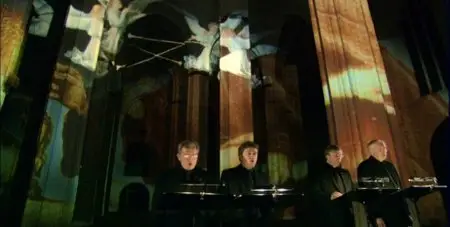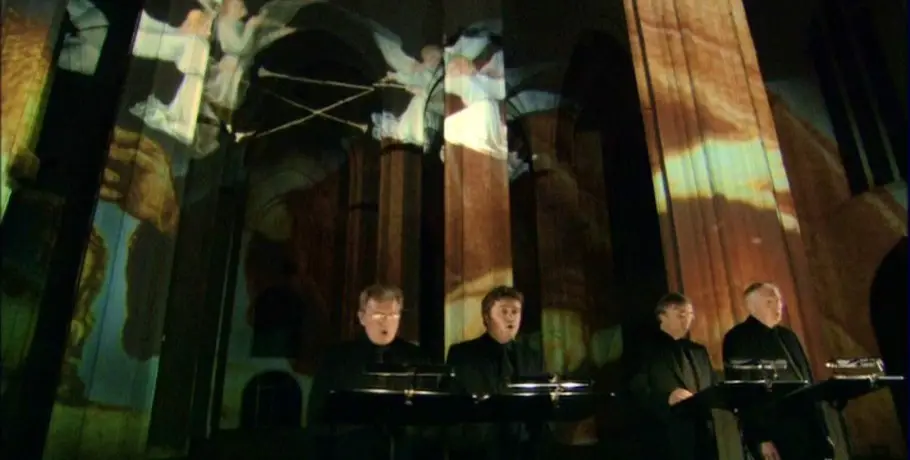Hilliard Ensemble - Thy Kiss of a Divine Nature / The Contemporary Perotin - DVD
DVD | DVDfab Rip | VIDEO_TS (100%) | covers | Booklet | 6,5 GB
CD | EAC FLAC (330 MB) | NO LOG | Embedded CUE | scans (20 MB) | OGG·160 (75 MB)
Arthaus Musik 100 695 (1995) | medieval
DVD | DVDfab Rip | VIDEO_TS (100%) | covers | Booklet | 6,5 GB
CD | EAC FLAC (330 MB) | NO LOG | Embedded CUE | scans (20 MB) | OGG·160 (75 MB)
Arthaus Musik 100 695 (1995) | medieval
lenguage version: German
subtitle languages: GB, F, SP, JP
menu languages: GB, D, JP
sound format: PCM Stero, DD 5.1, DTS 5.1
picture format: 16:9
running time: 95 minutes
Perotin and the film by Uli Anmüuer achieves an audiovisual symbiosis, which asks about the origins and the basis of medieval music, philosophy, architecture and religiousness. The film thus creates a musical painting with medieval chants by the Hilliard Ensemble, accompanied by a scientific dispute, and choreography by Johann Kresnilc. The chant, the dispute and the dance run like a thread throughout the film; they weave around and together attempt to bring Perotin's time and music back to life. The director did not so much employ the classic documentary format with interviews and a historical ambience, rather, his focus was on the presence of music and the staging of the images and the participants. The four scientists Martin Burckhardt, Rudolf Flotzinger, Christian Kaden and Jürg Stenzl, who were filmed in various places, such as the choir stalls of Schleswig Cathedral, discuss the fundamentals of Perotin's music. In the film, the scientists do not just engage in scholastic dispute, they also play around each other as part of a staged workshop discussion. Only, the workshop is a church; the church as a space where Perotin's music can and was able to develop. The film also opens up another sphere of experience; watching the renowned choreographer Johann Kresnik creating a dance. Through the medium of dance, the choreographer and the two dancers, Simona Furlani and Tanja Oetterli, look for ways and possibilities to make the lyrics of Perotin's vocal music comprehensible to us today. The worlds of medieval theology and of the modern conception of art meet in order to find a degree of mutual understanding in the artistic outcome. And in the end, when the scholarly dispute about the appropriate way to judge Perotin's music historically, and the choreographed dance as a video projection end up in the sacred space of a church, interwoven with the chanting of the Hilliard Ensemble, the film, in a contemporary way, shows the particular nature and the origins of European culture in a literally multidimensional form. As a result of the difficult and time-consuming 3 year research for the film, and the no less complex technical implementation involved, the director and his team travelled to many locations in Europe. The church of St. Petri, in Lübeck, was chosen as the projection room, which seemed predestined for the idea of a visual staging with its bare, white walls devoid of ornaments or furnishing. For tracking shots, sound recordings, the conceptual implementation and other shots, the cathedrals of Laon, Troyes and Schleswig, a village church near Pfullingen, as well as the cathedrals of NôtreDame and St. Denis in Paris were used as models for Perotin's work. The Gothic architecture of the French cathedrals with their unique spatial effects and religiously-historical, architectural language were thus not just cinematically transformed into the church in Lübeck, they also served as symbolic, stone reflections for the 12th and 13th centuries.
1. Perotinus' innovation
2. A letter to Martin Burckhardt
3. Leonin rehearsal
4. Rieman musical encyclopaedia
5. Cloister I
6. Music: Beata viscera (conductus)
7. Paris in the Middle Ages
8. Cloister II
9. Symposion I: Martin Burckhardt
10. Music: Laude jocunda (prosa)
11. The question of interpretation I
12. Cloister III
13. The question of interpretation II
14. Symposion II: Christian Kaden, sociologist of music
15. The question of interpretation III
16. Theatre rehearsal I: the black and the white Mary
17. Music: Descendit de celis I (organum)
18. The word becomes flesh (walk in the woods)
19. Music: Descendit de celis II (organum)
20. Theatre rehearsal II: the ear conception
21. Theatre rehearsal III: when God is no God…
22. Excursus: Perotin and the invention of money
23. Theatre rehearsal IV: tableau vivant
24. Symposion III: Jürg Stenzl, historian of music
25. Music: Alleluia nativitas (organum)
26. Symposion IV: dispute
27. Theatre rehearsal V: Mary as a letter
28. Music: viderunt omnes (quadruplum)
29. Theatre rehearsal VI: flawless projection screens
30. Theatre rehearsal VII: the power of imagination
31. The betrayal of nature
32. Music: Dum sigillum (conductus)
33. Music: Benedicamus domini (organum)
34. Credits
rapidshare links - DVD
rapidshare links - CD
THE HILLIARD ENSEMBLE
David James, countertenor
Rogers Covey-Crump, tenor
Steven Harrold, tenor
Gordon Jones, baritone





